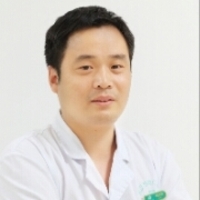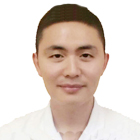Rhinoplasty in Chinese: Management of lower dorsum and bulbous nasal tip WANG Tai-ling, XUE Zhi-qiang, YU Da-shan, ZHANG Hai-ming, TANG Xiao-jun, WANG Jia-qi, YANG Xin,LUO Jia-lin and MA Ji-guang Keywords: rhinoplasty; suture techniques; grafts Background Bulbous nasal tips and lower dorsa are common facial features in Chinese people, and surgery to reshape these is frequently requested. The use of silicone implants in rhinoplasty has been widely used in China for many years, but is not suitable for patients seeking Caucasian tip shapes. The creation of an excessively high tip supported only by a silicone implant inevitably leads to implant extrusion. Although many rhinoplasty techniques have been used in Caucasian patients, there is currently no suitable method for Chinese patients, whose anatomy differs from that of Caucasians. The present study was aimed to investigate the clinical outcome of a novel method of rhinoplasty in Chinese people.Methods Eighty patients underwent rhinoplasty using our method between 2002 and 2006. We classified the patients into three types, according to the distance between tip defining points, and used different techniques accordingly. Furthermore, an innovative cartilage carving method and a tip fibro-fatty tissue flap were designed and combined with traditional techniques, such as insertion of silicone implant, cartilage grafts, suture techniques and cephalic trimming to reshape the nasal contours. The followup period was 10–60 months (average, 21 months).Results Remarkable modifications in nasal contours were achieved. No complications developed in any of the 80 patients. Seventy-eight patients were satisfied with the results. The outcomes remained unchanged over time.Conclusions Our method is effective and suitable for the treatment of Chinese patients with lower dorsa and bulbous nasal tips.Chin Med J 2009;122():
I
ncreasing numbers of Chinese people are seeking some kind of cosmetic surgery. Rhinoplasty has become popular in China so it is important for plastic surgeons to be skilled in this area. Lower dorsa and bulbous nasal tips are common reasons for seeking aesthetic rhinoplasty in Chinese patients.1-5 Simple silicone implant insertion is the most frequently used technique for augmentative rhinoplasty. However, this technique can only produce an altered nasal dorsum and tip modifications cannot always be adequately corrected. Several techniques for nasal tip plasty have been reported in Caucasians, including nasal tip grafts, suture techniques and cephalic trimming,6-8 but there is still no suitable method for dealing with Chinese patients, whose anatomy differs from that of Caucasians. METHODS DOI: 10.3760/cma.j.issn.0366-6999.2009.01.001Department 6 (Wang TL and Tang XJ), Department 7 (Yu DS), Department 3 (Wang JQ), Ping An Clinic (Yang X and Ma JG), Laser Department (Luo JL), Plastic Surgery Hospital of Chinese Academy of Medical Science & Peking Union Medical College, Beijing 100144, China Department of Plastic Surgery, China Japan Friendship Hospital, Beijing 100029, China (Xue ZQ)Ever Care XingFu Hospital, Beijing 100027, China (Zhang HM)Correspondence to: Dr. MA Ji-guang, Ping An Clinic, Plastic Surgery Hospital of Chinese Academy of Medical Science & Peking Union Medical College, Beijing 100035, China (Tel: 86-10-66182233. Fax: 86-10-66151156. Email: majiguang678@ sohu.com) SubjectsEighty patients (9 male and 71 female) underwent rhinoplasty between May 2002 and July 2006. The mean age was 26 years (range, 21–36 years). Sixty-one patients were primary cases and 19 patients were secondary cases, who had previously undergone silicone implant insertion but were dissatisfied with the resulting tip contour. All the patients were of Chinese ethnic origin. According to the distance between the tip defining points, we classified the 80 patients into three types: type 1 (12 patients, >6 mm and ≤8 mm); type 2 (36 patients, >8 mm and ≤10 mm); type 3 (32 patients, >10 mm). We further classified the three types into six subtypes according to the thickness of the soft tissue covering the domes and selected different techniques to treat them (Table 1). All surgery was performed by Dr. MA in the Plastic Surgery Hospital of Chinese Peking Union Medical College, Chinese Academy of Medical Sciences. Patients were followed up for 10–60 months (average, 21 months). Surgical techniques Local anaesthesia was achieved by infiltration of 0.5% lidocaine mixed with 1:200 000 epinephrine. All patients underwent bilateral infracartilaginous incisions and type 2 and 3 patients underwent transcolumellar incisions. Blunt dissection was continued just above the alar cartilages and below the nasal dorsal fascia. The cephalic segments Table 1. Surgical techniques and nasal type Types Skin type Techniques Type 1 Thin skin Silicone implant insertion Thick skin Silicone implant insertion + conchal cartilage graft Type 2 Thin skin Interdomal suture + silicone implant insertion + conchal cartilage graft Thick skin Transdomal and interdomal suture + silicone implant insertion + conchal cartilage graft + tip fibro-fatty tissue flap Type 3 Thin skin Domal cephalic trimming + transdomal and interdomal suture + silicone implant insertion + conchal cartilage graft Thick skin Domal cephalic trimming + transdomal and interdomal suture + silicone implant insertion + conchal cartilage graft + tip fibro-fatty tissue flap Figure 1. Three views of a nose. A: frontal view. B: profile view. C: - view. 1: L shaped silicone implant. 2: cartilage graft. 3: cephalic trimming of the lateral crura, 4: lower lateral cartilage. 5: interdomal suture. of the lower alar cartilage were trimmed and at least 5 mm of intact rim strip was preserved. The lateral crura were then freed to move upwards, if there were no other resisting forces and the musculus depressor septi nasi was also usually resected to achieve a retrousse nasal tip, in place of a ptotic tip.9 Interdomal and transdomal suturing techniques were then adopted to reshape the alar cartilages, using 5-0 monofilament nylon sutures. An L shaped silicone implant was inserted after carving. The columellae of the implant were carved into a thin, slim shape to produce a smooth transition zone and a natural looking outcome. To harvest an elliptical piece of conchal cartilage about 20 mm long and 10 mm wide, we firstly scored the convex side at a point 2/5 of the way along its length, to allow the superior part to bend to the concave side, as a tip graft. We then scored the inferior part and reversed the two transparent parts back to the concave side as a columellar strut (Figure 1). Lastly, we placed the graft above the silicone implant with the concave side down and sutured them together using 6-0 monofilament sutures, to prevent displacement (Figure 2). For thick skinned patients of types 2 and 3, we designed a tip fibro-fatty tissue flap, instead of the fibro-fatty tissue resection. We marked the preoperative tip range and the desired postoperative tip range. We then dissected the redundant fibro-fatty tissue outside the postoperative tip range and formed a fibro-fatty tissue flap. During this process, skin thickness was preserved. Lastly, we sutured the fibro-fatty tissue to the centre and fixed it to the cartilage graft using 6-0 absorbable sutures (Figure 3). Assessment methodEvaluation was -d on comparisons between the results Figure 2. Conchal cartilage carving. A: anterior view. B: profile view. Figure 3. 1: tip area. 2: fibro-fatty tissue flap. 3: tip defining points. (A) 1: the preoperative tip range. 2: the postoperative tip range. 3: tip fibro-fatty tissue flap. 4: lower lateral cartilage (B). and the preoperative designs and severe complications. We designed a questionnaire to assess each patient’s perception of five different aspects of the procedure, with each aspect worth 20 points (total, 100 points). The five aspects were: tip width, tip projection, dorsal contour, naso-frontal angle and columellar lobular angle. We classified the results into four categories according to the scores obtained: (1) excellent: scores for each aspect were ≥17; (2) good: scores for each aspect were ≥14; (3) fair: scores for each aspect were ≥12; (4) poor: scores for one or more aspects were
 杨艳清武汉市同仁医院副主任医师整形科
杨艳清武汉市同仁医院副主任医师整形科
 杨跃浙江省中医院主治医师整形科
杨跃浙江省中医院主治医师整形科
 杨跃浙江省中医院主治医师整形科
杨跃浙江省中医院主治医师整形科
 杨跃浙江省中医院主治医师整形科
杨跃浙江省中医院主治医师整形科
 杨跃浙江省中医院主治医师整形科
杨跃浙江省中医院主治医师整形科
 伊光中国人民解放军火箭军总医院主任医师整形科
伊光中国人民解放军火箭军总医院主任医师整形科